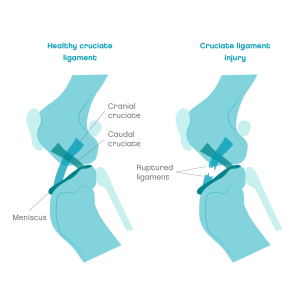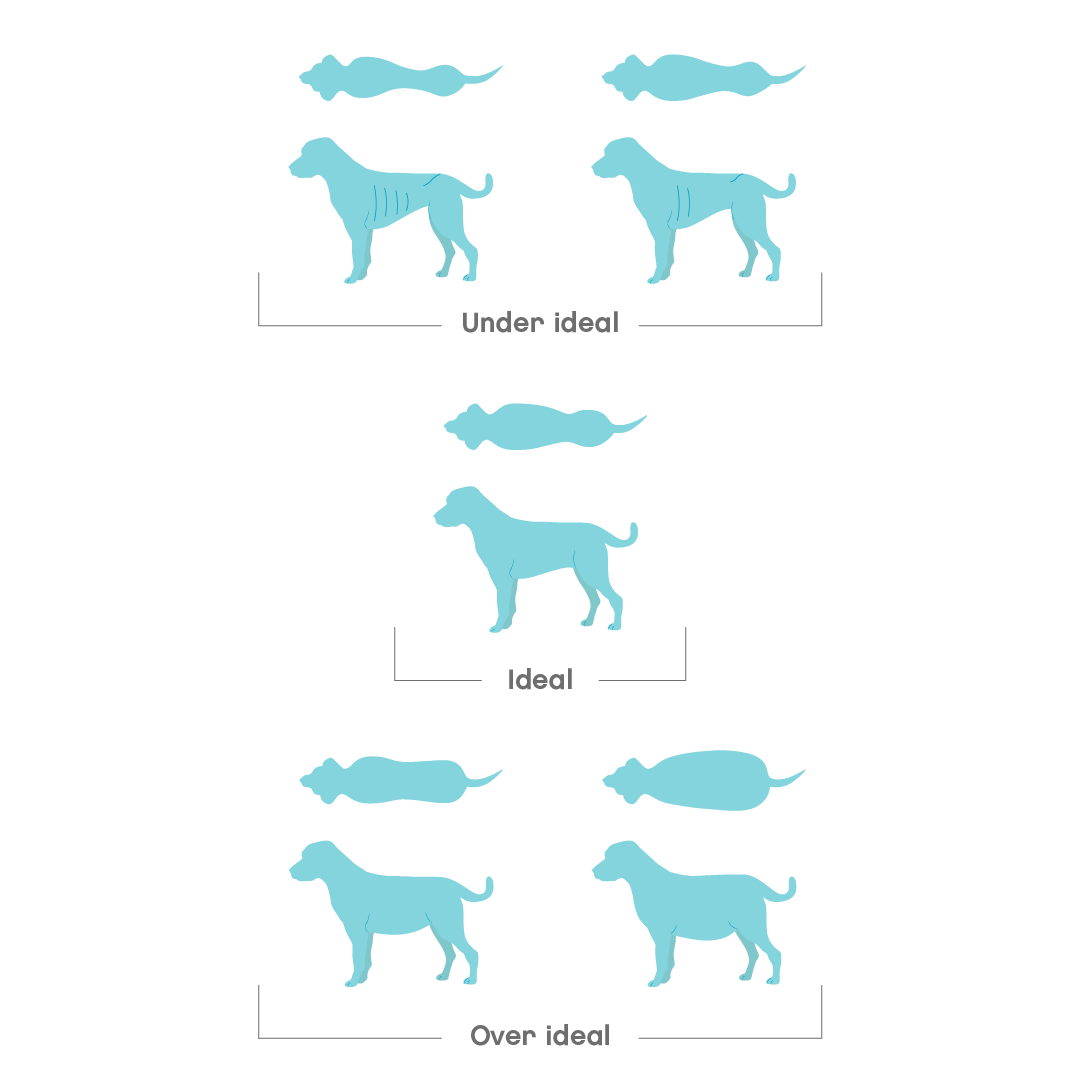Cruciate ligament disease is a common orthopaedic problem that results in back leg lameness. It usually requires surgery for treatment. Dogs of large and giant breeds are more prone to this condition, but it can affect dogs of any breed or age.
The most common form of knee ligament injury is the tearing of the cranial cruciate ligament (CrCL). It may occur as a result of trauma or due to an inherited weakness. Within one year of undergoing surgery, 20-50% of cases develop a ligament tear in the opposite knee, so treatment should begin as soon as possible to prevent further injury. This disease can also be called CrCL rupture, CrCL tear, anterior cruciate ligament (ACL) disease, or torn knee ligaments.
Overview
What is cruciate ligament disease in dogs?
Your dog’s knee is a complex structure consisting of multiple bones: thigh bone (femur), kneecap (patella), shinbone (tibia), ligaments, and meniscus.
The cranial cruciate ligament (CrCL) is one of four ligaments that hold the knee joint together.

If one of the cruciate ligaments is damaged, the knee becomes unstable and often very painful.
The CrCL can tear partially or completely.
Damage to the meniscus can occur in a large percentage of dogs with CrCL rupture.
Limping is often the first sign seen.
Causes of cruciate ligament injury include exercise, inherited weak ligaments, and obesity. Yet, any breed, size, or age of dog can injure their cruciate ligament.
As a result of this condition, limb function will deteriorate if not treated, and arthritis will progress.
Symptoms
What are the signs of cruciate ligament disease in dogs?
You might notice some or all of the following in your dog:
- Limping that can start suddenly, worsen, persist, or become occasional
- Painful leg
- Reluctance to exercise or difficulty getting up, jumping, or using stairs
- Swelling of the knee joint
- Sitting with the affected limb extended out to the side
- Loss of muscle mass in the affected leg
People express pain and discomfort differently from dogs, so although dogs may not whine, cry out, or hold up their affected limb constantly, the persistence of their lameness is a sign of pain.
Risk
Are some dogs more at risk of cruciate ligament disease?
Cruciate ligament disease is mostly seen in:
- Athletic dogs who suddenly jump or turn as they run. The ligaments are damaged by a twisting injury to the knee.
- Breeds that have weak ligaments, such as Newfoundland, Labrador Retriever, Rottweiler, Staffordshire Terrier, Mastiff, Akita, and Saint Bernard.
- Larger dogs weighing more than 22 kg are at greater risk of cruciate disease and tend to develop CrCL rupture at younger ages.
- Older age (7 to 10 years) can weaken the ligaments, which may tear more easily, particularly in dogs weighing more than 15 kg.
- Obese dogs can damage their ligaments due to the excess strain on the joints.
Diagnosis
How vets diagnose cruciate ligament disease in dogs
Complete tears of the CrCL
Is diagnosed by your vet using a combination of:
- Watching the way your dog walks
- Hands-on examination (including a special knee movement test, which is usually done under sedation)
- Radiographs (X-rays)
- Occasionally MRI
Partial CrCL tears
Can be more challenging to diagnose, requiring a visual inspection of the joint with:
- Exploratory surgery (open knee surgery)
- Arthroscopy (keyhole surgery with a camera on the joint)
This type of investigation may need to be conducted by a specialist vet in a referral hospital.
Vet treatment
Vet treatment for dogs with cruciate ligament disease
Treatment consists of surgical and medical management. Even when surgery is recommended, medical management after surgery is essential.
Surgery
Surgery is usually the recommended treatment option to restore function to the affected knee.
These repairs involve the structures around the ligaments, not the ligaments themselves. This is because bone healing is more efficient than ligament healing.
The surgery may need to be performed by a specialist vet at a referral hospital.
Depending on your dog’s medical needs, the vet may recommend the following surgical techniques:
- Extracapsular suture stabilisation
- Tibial plateau levelling osteotomy (TPLO)
- Tibial tuberosity advancement (TTA)
Medical management
Non-surgical treatment may only be possible in small dogs, in cases of partial CrCL tears, or in cases where surgery is not an option due to financial limitations or anaesthetic risk.
For best results, all of the following will be needed:
- Activity restriction for several weeks
- Anti-inflammatory and pain medication
- Weight control or weight loss
- Joint supplements to slow the progression of arthritis
- Rehabilitation and physiotherapy
- A custom-made knee brace may also be recommended to stabilise the damaged knee, reduce pain, and allow some return of function. However, there isn’t much research in veterinary medicine to support this option.
Home treatment
How to help your dog at home if they have cruciate ligament disease
Follow your vet’s recommendation and exercise restriction plan.
- Your vet’s plan will be very detailed for the first 6-8 weeks.
- Keep your dog rested by using a cage or leaving them in small rooms of the house with no access to high furniture (sofa or bed).
- Keep their minds busy by feeding them in slow feeders and play mats.
- Start physiotherapy as soon as possible and continue for the following 3-6 months. The protocol sessions will change as the bone heals and the main goal changes.
- A healthy weight is necessary both for the injured knee, as well as, to prevent the other knee from getting injured.
- Start them on a good joint supplement to slow the progression of arthritis.
- Lots of cuddles, love, and patience.
Living with a dog with cruciate ligament disease
Is post-operative care difficult?
There are a few points that can cause frustration due to the length of the treatment time. These are the exercise restrictions and physiotherapy.
Activity is highly restricted for 6-8 weeks after surgery.
The activity restriction may be less if a TPLO or TTA has been performed.
Within 3 months, good function should return to the limb if you follow your vet’s instructions and keep up with the physiotherapy.
Many joint supplements are available; which one should you choose?
The key ingredient a joint supplement should contain is:
- Green lipped mussel extract (a bivalve mollusc extract)
- Omega-3&6 fatty acids (polyunsaturated fatty acids)
Other ingredients that may also have an effect are:
- DPLA (a protein that is believed to have pain relief and mood elevating effects)
- SAMe (a compound found naturally in the body)
- CBD (an active ingredient in cannabis extracted from hemp plant)
- Hyaluronic acid (a component of joint fluid that gives it elasticity)
- Chondroitin sulphate (extracted from mammalian cartilage, normally cow windpipes)
- Collagen hydrosylates (also known as gelatin; it’s made from collagenous structures of mammals such as bovine tendons)
- Glucosamine (a natural compound found in cartilage)
- Vitamin E
Are physiotherapy and rehabilitation important?
In order to improve limb function and quality of life, this condition typically requires expensive surgery and physiotherapy.
For a successful recovery and the prevention of injury to the other knee, physiotherapy is essential.
Physiotherapy can begin the day after surgery, continue for 6–8 weeks, and be maintained for at least 3 months.
Use the following links to find qualified professionals:
- Physiotherapy: The Register of Animal Musculoskeletal, Practitioners (RAMP), The Association of Chartered Physiotherapists in Animal Therapy (ACPAT), National Association of Veterinary Physiotherapists (NAVP)
- Hydrotherapy: National Association of Registered Canine Hydrotherapists, Canine Hydrotherapy Association
The progression of arthritis is inevitable
To slow the progression of the disease, we recommend starting your dog on a good joint supplement as well as modifying their exercise regime over time.
See our arthritis article for more information.
Prevention
How to prevent your dog from getting cruciate ligament disease?
Weight control is the key
- If your dog is overweight, the post-surgical recovery time will be much longer.
- Obesity also greatly increases the risk of injury to the other knee, especially during the recovery period.
- Weight loss is as important as surgery in ensuring a rapid return to normal function.
- Vets and nurses can help develop an appropriate weight-loss plan for your pet.
- Check your dog’s body score condition (BSC) to see if they are overweight.
Body Condition Scoring (BCS) in dogs
Body Condition Score (BCS) is a scale that gives a practical evaluation of the fat coverage of your dogs body. By checking how easy or not it is to feel certain bony areas of the body, a score is then produced. There are several scales, from 1 to 5 or 1 to 9. The ideal body condition lies in the middle, so either 3/5 or 5/9.
The body areas normally checked for fat coverage are:
1. ribs and spine
2. hips and shoulders
3. waist

Here are a few tips on how to do it.
With your pet in a standing position:
- Place your hands on the rib cage and gently feel for each rib, without pressing too hard
- Feel the waist and look from the top and the side (if you have a very furry breed, it may be harder to assess)
- Feel the spine, which runs down the middle of the back
- Feel the top of the hips and shoulders
When to worry
When you should be worried about your dog with cruciate ligament disease?
If your dog was diagnosed with CrCL disease, contact your local vet practice if they are:
- Not improving despite treatment
- Painful or stiff or there is swelling in any joint
- Struggling to run, jump, or use the stairs
- Vomiting, diarrhoea, or loss of appetite, if medication has been prescribed
Joii can help:
- If your dog had treatment for CrCL disease and you need tips to keep them calm and rested at home
- If your dog is vomiting, has diarrhoea, or a loss of appetite, if medication has been prescribed
- If you need help and advice on slowing the progression of arthritis








